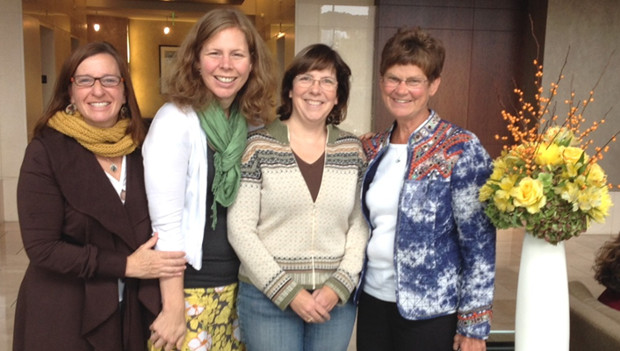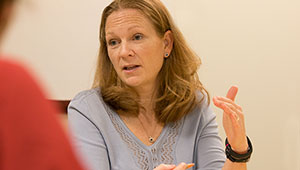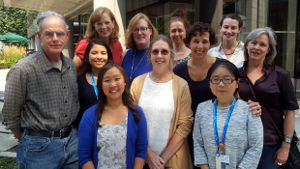Using breast MRI after cancer may lead to unneeded biopsies

Susan Brandzel, MPH; Karen Wernli, PhD; Dianne Johnson; and Mary Bush
Kaiser Permanente-led BCSC study among largest to evaluate adding MRI surveillance for breast cancer survivors
SEATTLE, June 4, 2019—When breast cancer survivors were screened using breast magnetic resonance imaging (MRI), they had more than twice as many biopsies as did those screened using mammography alone. The journal Radiology published this new research from a large Breast Cancer Surveillance Consortium (BCSC) study as “Surveillance Breast MRI and Mammography: Comparison in Women with a Personal History of Breast Cancer,” with an accompanying editorial.
Because of these extra biopsies, breast MRI detected more second cancers—but probably no additional ones that routine annual mammography would not have found, said study leader Karen Wernli, PhD, an associate investigator at Kaiser Permanente Washington Research Institute (KPWHRI) and an affiliate associate professor of health services at the University of Washington School of Public Health.
So the extra screening is not necessarily an improvement over what would have been detected in usual care with mammography, Dr. Wernli said. In fact, surveillance MRI and mammography did not differ in their ability to distinguish breast cancer from other findings (sensitivity) or to rule cancer out (specificity), she explained.
After women complete treatment for breast cancer, guidelines recommend annual mammography to screen for second breast cancers, Dr. Wernli said. “But our previous research showed that in practice, breast MRI is also being used to screen a growing number of women who have had breast cancer—often between yearly mammograms,” she added. “But more testing isn’t always better.”
Unlike prior studies, this one adjusted for differences between women who only received mammography and women who received breast MRI in addition to mammography. The women who received breast MRI tended to have a more advanced stage of cancer, denser breasts, and diagnosis at a younger age, which can all raise the risk of second cancers. This might be one reason for the slightly higher cancer rate the study found with the addition of breast MRI, Dr. Wernli explained.
Further, women who had more education and income were also more likely to receive breast MRI—not specifically because they had higher risk of second cancers, but because they likely had more access to resources, she added.
Patients’ perspectives
The study engaged stakeholders including patient partners who have had breast cancer. Two of these patients, Dianne Johnson and Mary Bush, are study coauthors. “They helped us stay focused on the real-life experiences behind the numbers,” Dr. Wernli said.
Some women may feel reassured when they have a biopsy that shows no cancer, while others want to avoid unnecessary biopsies. Ms. Johnson said, “As someone who has had breast cancer and has listened to many other women across the country as part of this study, having to get another biopsy after already being treated for cancer raises women’s anxiety and distress until they have the result—but most will endure the stress to be sure about whether the finding is cancer.”
Supplementing mammography with breast MRI is recommended for women at high risk for breast cancer (e.g., with certain mutations and family histories). In 2018, the American College of Radiology recommended yearly breast MRI also for breast cancer survivors who either have dense breasts or had breast cancer diagnosed before age 50. This study focused on the use of breast MRI only in women with prior breast cancer.
“Evidence about breast MRI’s benefits and harms in breast cancer survivors is lacking,” Karla Kerlikowske, MD, a study coauthor and professor of medicine and of epidemiology and biostatistics at the University of California, San Francisco and Veterans Affairs. “This study helps fill that gap. And women with prior breast cancer need to remember to continue with annual mammography.”
This is the largest and most comprehensive study of its kind to date, including more than 13,000 women aged 18 or older diagnosed with stage 0–III breast cancer. They were screened with nearly 34,000 mammograms and more than 2,500 breast MRIs from 2005 to 2012. The study used data from five registries in the BCSC: The Carolina Mammography Registry, Kaiser Permanente Washington, New Hampshire Mammography Network, San Francisco Mammography Registry, and Vermont Breast Cancer Surveillance System. The National Cancer Institute of the National Institutes of Health, and the Patient-Centered Outcomes Research Institute (PCORI), fund the BCSC.
What’s next?
The research team is now studying whether using three-dimensional (3-D) mammography, also known as tomosynthesis, helps improve the accuracy of cancer detection in women who have had breast cancer. Next, the research team wants to determine whether any subgroups of women who have had breast cancer might benefit more than others from breast MRI surveillance. If so, it may be possible to develop personalized surveillance based on risk of second cancers—and then create a new aid for patients and clinicians to use in shared decision making.
Other co-authors on the study were Laura Ichikawa, PhD, Diana Buist, PhD, and Susan Brandzel, MPH, of KPWHRI; Diana Miglioretti, PhD, of KPWHRI and the University of California, Davis; Janie M. Lee, MD, of the University of Washington and Seattle Cancer Care Alliance, who is also an affiliate investigator at KPWHRI; Louise M. Henderson, PhD, of the University of North Carolina, Chapel Hill; Larissa Nekhlyudov, MD, MPH, of Brigham and Women’s Hospital, in Boston; Tracy Onega, PhD, of Dartmouth Medical School, in Hanover; Brian L. Sprague, PhD, of the University of Vermont, in Burlington; and Constance Lehman, MD, of Massachusetts General Hospital, in Boston.
PCORI funded this study through award CE-1304-6656. This study was registered at clinicaltrials.gov: NCT02212834.
Breast cancer is an active area of research at Kaiser Permanente.
About Kaiser Permanente Washington Health Research Institute
Kaiser Permanente Washington Health Research Institute (KPWHRI) improves the health and health care of Kaiser Permanente members and the public. The institute has conducted nonproprietary public-interest research on preventing, diagnosing, and treating major health problems since 1983. Government and private research grants provide our main funding. Follow KPWHRI research on Twitter, Facebook, and LinkedIn, or subscribe to our free monthly newsletter.
About Kaiser Permanente
Kaiser Permanente is committed to helping shape the future of health care. We are recognized as one of America’s leading health care providers and not-for-profit health plans. Founded in 1945, Kaiser Permanente has a mission to provide high-quality, affordable health care services and to improve the health of our members and the communities we serve. We currently serve more than 12.4 million members in eight states and the District of Columbia. Care for members and patients is focused on their total health and guided by their personal Permanente Medical Group physicians, specialists and team of caregivers. Our expert and caring medical teams are empowered and supported by industry-leading technology advances and tools for health promotion, disease prevention, state-of-the-art care delivery and world-class chronic disease management. Kaiser Permanente is dedicated to care innovations, clinical research, health education and the support of community health. For more information, go to: kp.org/share.
co-researcher
Laura E. Ichikawa, MS
Principal Collaborative Biostatistician
Kaiser Permanente Washington Health Research Institute
healthy findings blog

What to expect after a screening breast MRI vs. mammography alone
In a study in JAMA Internal Medicine, Diana Buist and the Breast Cancer Surveillance Consortium report that screening MRI leads to more biopsies, finding fewer cancers, regardless of personal history of breast cancer.

Can standardized CT scans improve safety?
Dr. Diana Miglioretti and University of California colleagues are developing and testing a new way to lower radiation doses while still producing sharp images.
research funding

KPWHRI shares in $17 million grant to improve breast screening
Support from the National Cancer Institute will enable researchers to continue the work of the Breast Cancer Surveillance Consortium to collect imaging data and personalize screening.
Media contact
For more on Kaiser Permanente Washington Health Research Institute news, please contact:
Bianca DiJulio
bianca.s.dijulio@kp.org
206-660-8333
After-hours media line: 206-448-4056



